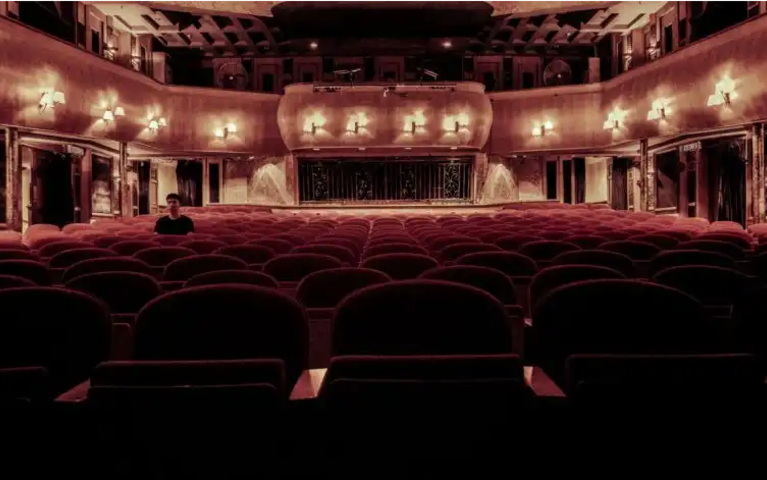Collective Consciousness, Real and Imagined

Imagine sitting in Studio Misr, one of the oldest studios in the Arab world. The white walls, once the elegant backdrop of many Egyptian classics, have now become greyed by the passage of time. The alleyways once graced by movie stars such as Faten Hamama and Omar Sharif are now left to abandon. The cafeteria looks more like a catering facility than a restaurant terrace, and the pre-made sets have become tacky and derelict.
Now imagine one of the sets being used to shoot the latest song-and-dance comedy produced by the infamous Ahmed al-Sobky. Imagine the director, sitting next to the crane, wanting to move on to the next shot, only to be rebuffed by the producer, who orders the camera to keep rolling on the dancer’s body. The singer and the orchestra play, stop, and restart multiple times under Sobky’s imperious command, while bystanders on location watch the latest musical hit being crafted on stage.
Most intellectuals in Cairo watching this scene would wail over the decline of Egyptian cinema. They would lament that what was once a refined and glamorous art has now degenerated into lowbrow entertainment. This entertainment sells, they would say, but at the expense of the nation’s collective consciousness, which is being polluted by glorified thugs and vulgar belly dancers. While this is a common opinion among intellectuals, I withheld such judgment when I witnessed that very scene in Studio Misr in 2014.
I am, by training, an anthropologist of cinema, someone who is interested in filmmaking as a social practice. In 2014, I was doing field research on the Egyptian film industry. I wanted to know how films are made and why filmmakers made them in the way that they did. To this end, I had to withhold my own judgments and listen to what filmmakers had to say. I wanted to understand their perspective before asserting, as so many critics do, that there were “good” and “bad” films for the nation’s collective consciousness.
I discovered while doing fieldwork that there is no direct connection between filmmaking and any presumed collective consciousness. First, there is a key buffer between the moment when a film is made and the moment when it reaches a mass audience: distribution. No matter what the film looks like, it will never make it to any audience if it is not well distributed. Film distribution across the Arab world has long been controlled by very few distributors who wield disproportionate power over what does and does not get shown to the public. Well-connected productions meeting the capricious criteria set by distributors will have no trouble getting out into the world, but many, if not most films, will not reach enough people to have a significant effect on their collective consciousness.
Second, even when a film does reach a broader audience, there is no guaranteeing how the audience will react – will enough people want to buy tickets? will they like it? will they find it convincing? will they find it funny when they should not? There are too many questions to be answered accurately by any single filmmaker or distributor. Audiences are unpredictable – some of the biggest hits are entirely unexpected, while some of the biggest flops are weighed down by overblown expectations.
The truism that cinema directly shapes collective consciousness becomes difficult to believe in light of these uncertainties. Critics and intellectuals worried about cinema’s effect on the collective mind assume that filmmakers are pouring images straight into empty brains thirsting to watch more and more. This metaphor does not acknowledge the pressures of tight distribution networks over production, nor does it give enough respect to the independent minds of viewers and their ability to receive, reject, or respond to films. These are two important lessons to be drawn from cinema anthropology and cultural studies, especially in the works of Raymond Williams and Stuart Hall.
Although filmmakers have no direct access to their audience’s consciousness, they try to imagine what this consciousness looks like. This is what cinema anthropologists call an “imagined audience”. Well before an actual audience watches a film, filmmakers and film distributors are imagining what a possible audience will think about a certain scene, a certain shot, a certain character, a certain location. The imagined audience is a recurring topic on set and in distribution meetings, because many decisions are made not based on how the audience will really react, but how the audience is imagined to react, and what kind of audience is targeted.
Think back to the Sobky production in Studio Misr. The real audience of these films is quite diverse in practice – men and women, teenagers and adults, working-class and middle-class cliques in search of entertainment. The imagined audience, however, is much narrower. It is embodied by the throngs of young “popular” men crowding ticket counters in downtown Cairo at the end of Ramadan to watch the latest action-adventure or comedy movie. This is the audience addressed by Sobky films, which features themes that are to appeal to this rowdy crowd – violence, drugs, popular weddings, and belly dancing.
This downtown Cairo audience is integral to the commercial success of all Egyptian films, including the ones made by Sobky, but its image as a crowd of rowdy young men is exaggerated. Moreover, the way in which these young men are portrayed on screen is not at all representative of their actual lives. And all in all, filmmakers have limited control over how people will react to their films. They can only ever create partial representations based on what they imagine their audience to be, yet these representations are never perfectly accurate nor guaranteed to reach out to everyone without a secure distribution base.
There is a big gap, therefore, between the imagined audience and the way in which consciousness is collectively shaped through complex political, economic, and social means. Collective consciousness is only imagined to be whole and homogenous, but it is never so in reality. As Raymond Williams puts it so eloquently, in his essay Culture is Ordinary, “there are in fact no masses, but only ways of seeing people as masses.”
*Chihab El Khachab is a Junior Research Fellow in Christ Church, University of Oxford. His academic work on Egyptian cinema, media, and popular culture has appeared in several specialised magazines.















